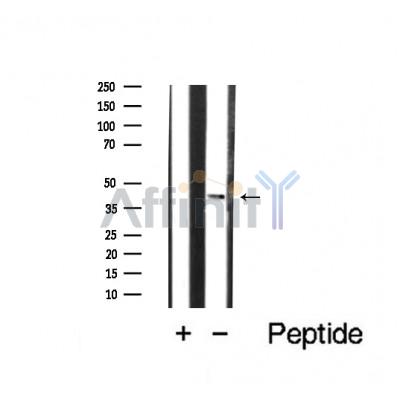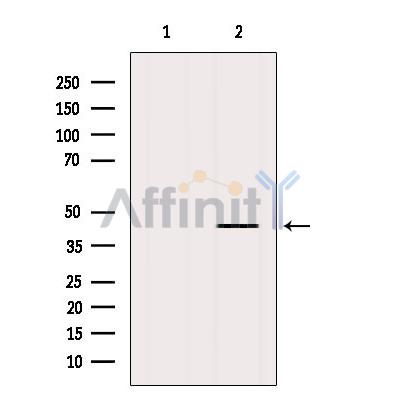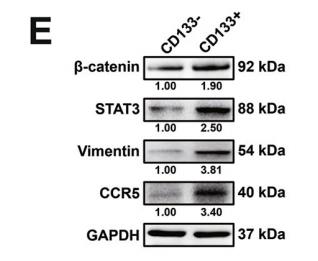| 产品: | CCR5 抗体 |
| 货号: | AF6339 |
| 描述: | Rabbit polyclonal antibody to CCR5 |
| 应用: | WB IF/ICC |
| 文献验证: | WB, IF/ICC |
| 反应: | Human, Mouse, Rat, Monkey |
| 预测: | Pig, Bovine, Rabbit, Chicken |
| 分子量: | 40kDa; 41kD(Calculated). |
| 蛋白号: | P51681 |
| RRID: | AB_2835195 |
产品描述
*The optimal dilutions should be determined by the end user.
*Tips:
WB: 适用于变性蛋白样本的免疫印迹检测. IHC: 适用于组织样本的石蜡(IHC-p)或冰冻(IHC-f)切片样本的免疫组化/荧光检测. IF/ICC: 适用于细胞样本的荧光检测. ELISA(peptide): 适用于抗原肽的ELISA检测.
引用格式: Affinity Biosciences Cat# AF6339, RRID:AB_2835195.
展开/折叠
AM4 7; C C chemokine receptor type 5; C C CKR 5; C-C chemokine receptor type 5; C-C CKR-5; C-C motif chemokine receptor 5 A159A; CC Chemokine Receptor 5; CC Chemokine Receptor Type 5; CC CKR 5; CC-CKR-5; CCCKR 5; CCCKR5; CCR 5; CCR-5; CCR5; CCR5 chemokine (C C motif) receptor 5; CCR5_HUMAN; CD 195; CD195; CD195 Antigen; Chemokine C C motif receptor 5; Chemokine receptor CCR5; CHEMR13; CKR 5; CKR5; CMKBR 5; CMKBR5; FLJ78003; HIV 1 Fusion Coreceptor; HIV-1 fusion coreceptor; HIV1 fusion coreceptor; IDDM22; MIP-1 alpha receptor;
抗原和靶标
Highly expressed in spleen, thymus, in the myeloid cell line THP-1, in the promyeloblastic cell line KG-1a and on CD4+ and CD8+ T-cells. Medium levels in peripheral blood leukocytes and in small intestine. Low levels in ovary and lung.
- P51681 CCR5_HUMAN:
- Protein BLAST With
- NCBI/
- ExPASy/
- Uniprot
MDYQVSSPIYDINYYTSEPCQKINVKQIAARLLPPLYSLVFIFGFVGNMLVILILINCKRLKSMTDIYLLNLAISDLFFLLTVPFWAHYAAAQWDFGNTMCQLLTGLYFIGFFSGIFFIILLTIDRYLAVVHAVFALKARTVTFGVVTSVITWVVAVFASLPGIIFTRSQKEGLHYTCSSHFPYSQYQFWKNFQTLKIVILGLVLPLLVMVICYSGILKTLLRCRNEKKRHRAVRLIFTIMIVYFLFWAPYNIVLLLNTFQEFFGLNNCSSSNRLDQAMQVTETLGMTHCCINPIIYAFVGEKFRNYLLVFFQKHIAKRFCKCCSIFQQEAPERASSVYTRSTGEQEISVGL
种属预测
score>80的预测可信度较高,可尝试用于WB检测。*预测模型主要基于免疫原序列比对,结果仅作参考,不作为质保凭据。
High(score>80) Medium(80>score>50) Low(score<50) No confidence
研究背景
Receptor for a number of inflammatory CC-chemokines including CCL3/MIP-1-alpha, CCL4/MIP-1-beta and RANTES and subsequently transduces a signal by increasing the intracellular calcium ion level. May play a role in the control of granulocytic lineage proliferation or differentiation.
(Microbial infection) Acts as a coreceptor (CD4 being the primary receptor) of human immunodeficiency virus-1/HIV-1.
Sulfated on at least 2 of the N-terminal tyrosines. Sulfation contributes to the efficiency of HIV-1 entry and is required for efficient binding of the chemokines, CCL3 and CCL4.
O-glycosylated, but not N-glycosylated. Ser-6 appears to be the major site. Also sialylated glycans present which contribute to chemokine binding. Thr-16 and Ser-17 may also be glycosylated and, if so, with small moieties such as a T-antigen.
Palmitoylation in the C-terminal is important for cell surface expression, and to a lesser extent, for HIV entry.
Phosphorylation on serine residues in the C-terminal is stimulated by binding CC chemokines especially by APO-RANTES.
Cell membrane>Multi-pass membrane protein.
Highly expressed in spleen, thymus, in the myeloid cell line THP-1, in the promyeloblastic cell line KG-1a and on CD4+ and CD8+ T-cells. Medium levels in peripheral blood leukocytes and in small intestine. Low levels in ovary and lung.
Interacts with PRAF2. Efficient ligand binding to CCL3/MIP-1alpha and CCL4/MIP-1beta requires sulfation, O-glycosylation and sialic acid modifications. Glycosylation on Ser-6 is required for efficient binding of CCL4. Interacts with GRK2. Interacts with ARRB1 and ARRB2. Interacts with CNIH4.
(Microbial infection) Interacts with HIV-1 surface protein gp120.
(Microbial infection) May interact with human cytomegalovirus/HHV-5 protein UL78.
Belongs to the G-protein coupled receptor 1 family.
研究领域
· Cellular Processes > Transport and catabolism > Endocytosis. (View pathway)
· Environmental Information Processing > Signaling molecules and interaction > Cytokine-cytokine receptor interaction. (View pathway)
· Human Diseases > Infectious diseases: Parasitic > Toxoplasmosis.
· Human Diseases > Cancers: Overview > Viral carcinogenesis.
· Organismal Systems > Immune system > Chemokine signaling pathway. (View pathway)
文献引用
Application: WB Species: human Sample: prostate cancer cells
Application: IF/ICC Species: Mouse Sample:
Application: IHC Species: human Sample: HCC and para-carcinoma live tissues
限制条款
产品的规格、报价、验证数据请以官网为准,官网链接:www.affbiotech.com | www.affbiotech.cn(简体中文)| www.affbiotech.jp(日本語)产品的数据信息为Affinity所有,未经授权不得收集Affinity官网数据或资料用于商业用途,对抄袭产品数据的行为我们将保留诉诸法律的权利。
产品相关数据会因产品批次、产品检测情况随时调整,如您已订购该产品,请以订购时随货说明书为准,否则请以官网内容为准,官网内容有改动时恕不另行通知。
Affinity保证所销售产品均经过严格质量检测。如您购买的商品在规定时间内出现问题需要售后时,请您在Affinity官方渠道提交售后申请。产品仅供科学研究使用。不用于诊断和治疗。
产品未经授权不得转售。
Affinity Biosciences将不会对在使用我们的产品时可能发生的专利侵权或其他侵权行为负责。Affinity Biosciences, Affinity Biosciences标志和所有其他商标所有权归Affinity Biosciences LTD.




